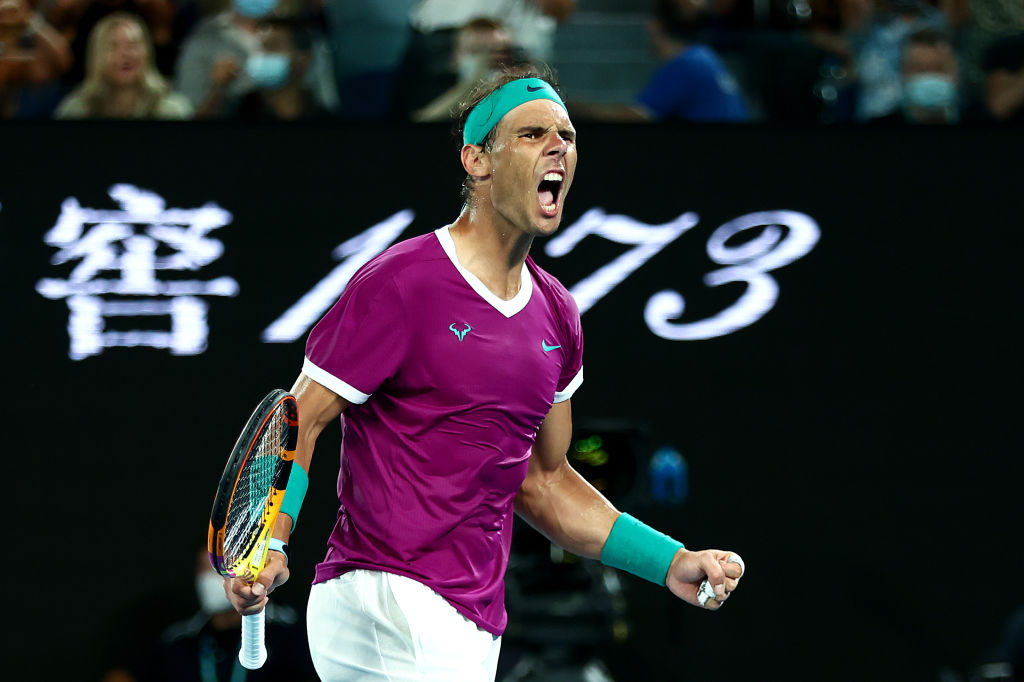ScoPo’s Powerplays: Who’s making a gritty comeback?

Rafael Nadal celebrates winning set point in his men's singles final match at the 2022 Australian Open. Pic Clive Brunskill, Getty Images
Healthcare and life sciences expert Scott Power, who has been a senior analyst with Morgans Financial for 24 years, explains what the movers and shakers have been doing in health and gives his ASX powerplays.
Everyone loves a comeback. Just take Rafael Nadal’s comeback during the Australian Open Men’s singles final on Sunday night, which raked in some impressive TV ratings in Australia and globally.
The World No.1 dashed World No.2 Daniil Medvedev’s hope of a back-to-back grand slam win, in a match which lasted more than five hours. According to reports, Nadal’s fighting spirit and ability to come back from early set losses saw a peak audience of ~3.14 million at one point.
The match was the most watched program across British households on Sunday afternoon, while the BBC attracted a peak rating of 1.5 million viewers for their highlights reel of the final.
Segue to markets, where the healthcare sector has also come back strongly from last week’s losses to rise ~3.5% in the past week which is the same as the broader market.
The ASX in general got a boost this week after the RBA board decided against lifting interest rates at its first official meeting of the year. While the RBA formally ended its quantitative easing program, rising inflation has had the market jittery it may lift interest rates above its record low of 0.1%.
Governor Phil Lowe said the central bank is looking on track to achieve its wage growth and inflation targets “for the first time in years”. But Lowe reiterated that it’s too early to tell whether inflation will remain sustainably within the RBA’s 2-3% target band.
For Power, while markets remain volatile, this week has seen a much-needed rally for the healthcare sector.
“It was the bounce we were looking for as the sector had been oversold so we were looking for a rebound and got it,” he said.
“The selloff has been driven by interest rate fears, supply chain issues and so on but the market seems to be looking through that a bit but in terms of healthcare we are still in rotation from growth to value.
“What we are seeing is still the sector being oversold and little bounces but I think we still have some more pain to endure.”
However, he said it’s during the down times investors should be jumping to invest in quality companies.
“Things do get oversold and we do want to find those situations and jump on them pretty quick,” he said.
Themes of the week
A lot of financial results were coming through for health stocks this week with Power noting Ansell (ASX:ANN) as a big disappointment in the larger end of the market, with its share price tumbling ~17% to $25.87.
One of the glamour stocks of the COVID-19 pandemic operating in the personal protective equipment (PPE) space, Morgans reduced its 12-month target price for Ansell from $41.87 to $28.95 after the company downgraded its forecasted earnings.
“No one saw the profit downgrade coming mostly caused by supply chain issues, cost pressures and we were taken by surprise as was the market,” he said.
On the positive side Impedimed (ASX:IPD) has risen ~12.5% to 18 cents this week on the back of positive Q2 FY22 results. Furthermore, the company has seen its PREVENT trial results peer-reviewed and published in the journal Lymphatic Research ad Biology.
The trial showed intervention in patients with early detection of cancer-related lymphoedema using Impedimed’s L-Dex technology resulted in a lower rate of progression to chronic disease, compared to patients with early detection from volume measurements using a tape measure.
“The trial was finished about 12 months ago and they had been trying to get it peer reviewed and published into one of the medical journals and it’s taken longer than expected but it was a turning point for them,” Power said.
“It helps their case for the private insurers to adopt the technology and they are also going to make an application to the body which makes the guidelines as to how cancer gets treated.”
Last Week’s Powerplay, imaging tech company Mach7 (ASX:M7T), was up more than ~17% to 78 cents after posting a solid Q2 FY22 cashflow report, showing growth in annual recurring revenue (ARR) and sales orders. It’s on track to achieve a 43% uptick on FY21 growth to $28 million and a positive EBITDA for FY22.
“We think they are very much undervalued at the moment and have a 12-month target of $1.55,” Power said.
Adelaide-based cold cathode X-ray tech MicroX (ASX:MX1) reported underwhelming sales but has a positive outlook with its technology expected to deliver sales mid-year. The company is developing higher-powered mobile X-ray technology. Bomb-detection technology is also on their growth horizon.
“They’re a really interesting story and one we are flagging as being well sought-after as the year goes on,” he said.
Small cap health imaging company Volpara (ASX:VHT) saw its share price recover and rise ~11% to 0.89 cents after delivering a strong Q3 FY22. The company, which specialises in the early detection of breast cancer, is on track to reach revenue guidance of $25 million for the year.
Larger health imaging company ProMedicus (ASX:PME) also recovered, up 7.20% to $45.56.
“It’s a high PE growth stock which has come under a lot of pressure lately but has recovered this week and is a good quality company which we’ve just been looking at an opportunity to buy,” Power said.
Firebrick IPO
Firebrick Pharma (ASX:FRE) was the hot new entrant to the bourse, almost tripling on debut. Listing at 12:30 AEDT on Monday after raising $7m at 20c per share, Firebrick promptly surged to almost 60c on day one.
The company’s patented nasal spray, Nasodine, targets nasal viruses causing the common cold, with trials also testing its efficacy at preventing COVID-19 transmission. The company is hopeful of having Nasodine approved by regulators later this year.
“It’s early stage stuff but you can’t take away from Firebrick who has raised the money and the share price has already gone up multiple times,” Power said.
“It’s in the attractive space of coming up with treatments for COVID.”
ScoPo’s Powerplays
The company Power thinks stands out this week and has been oversold within the market is a small cap Morgans was involved in floating in November, 2021.
Cardiac-focused Silicon-Valley based EBR Systems (ASX:EBR) is working on a new kind of “leadless” pacemaker system called WISE, and has the backing of major US funds.
EBR’s proprietary WiSE Technology is designed to eliminate the need for a lead to the left ventricle in Cardiac Resynchronization Therapy (CRT), and the associated complications.
EBR aims to expand this technology into other applications in the $11 billion cardiac rhythm management market.
“We raised $110 million at US$1.08 per share and you can see now it’s got down to around 60 cents and is currently around 76 cents, so taken a fair bit of pain,” Power said.
“These are one of those situations that get oversold and investors flee the speculative market but we think it’s really due to come back as nothing has changed.”
EBR announced that it’s on track with SOLVE, a pivotal clinical trial in the US. Recruitment is scheduled for completion mid-year with results towards the end of 2022.
In its notes on ERB Morgans continues to view its lead product “WISE as truly differentiated wireless cardiac pacing device, addressing the multibillion dollar cardiac resynchronisation therapy (CRT) market in patients with moderate to severe heart failure.”
Furthermore, ERB is well-funded for future growth with cash of US$78.2 million as at December 31, 2021.
Morgans has a speculative buy rating on the stock with a 12-month target price of $1.84.
“It is a very exciting company with a lot of prospects but you just have that rotation out of growth essentially so the price is down,” Power said.
Stockhead has not provided, endorsed or otherwise assumed responsibility for any financial product advice contained in this article.

UNLOCK INSIGHTS
Discover the untold stories of emerging ASX stocks.
Daily news and expert analysis, it's free to subscribe.
By proceeding, you confirm you understand that we handle personal information in accordance with our Privacy Policy.








